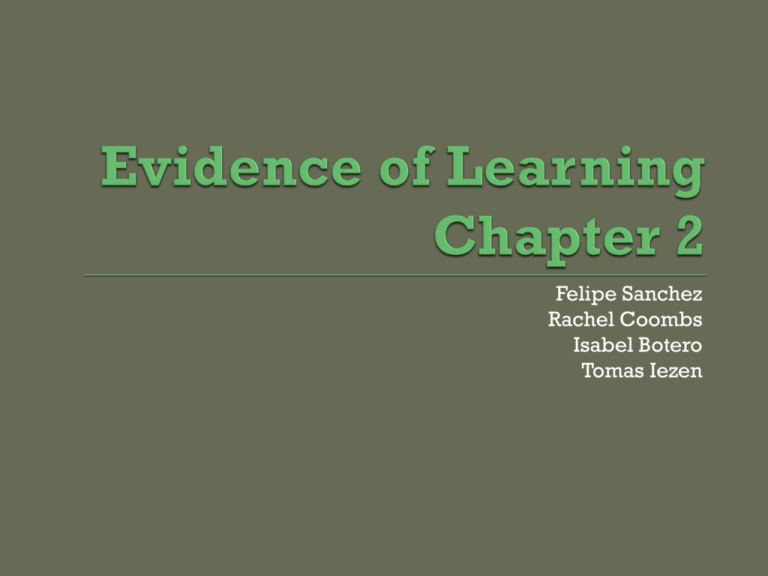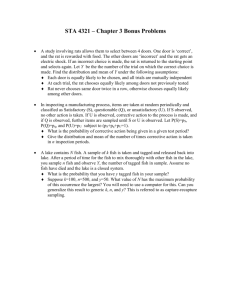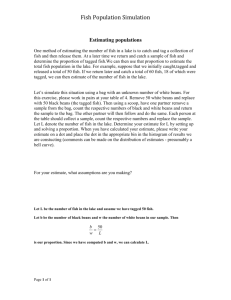File
advertisement

Felipe Sanchez Rachel Coombs Isabel Botero Tomas Iezen Rachel Coombs A proportion is an equation stating that 2 ratios are equal. A ratio is the comparison of 2 numbers. 4/16 = X/2 4/16 = X/2 First, you must get X by itself. The opposite of division is multiplication, so you divide by 2 on each side. 2● 4/16 = 2● X/2 That cancels out 2, so all you have left to do is multiply 2 by 4/16. 2● 4/16 = .5 X = .5 Tim wanted to know the colors of hair of people compared to others. Hair colors Grade Brown Hair Black Hair Blonde Hair Red Hair 7th Grade 12 4 10 1 8th Grade 12 6 9 0 7th graders with brown hair to 8th graders with brown hair: 12:12 Red heads to students in 7th grade: 1:27 Black haired 8th graders to blonde haired 7th graders: 6:10 Rachel Coombs Biologists need to know the population number of types of animals in a habitat. Instead of counting each animal, they have a process called capture-recapture. Biologists have tagged 120 fish in a lake. The results say they have only tagged 13% of the fish. You need to figure out how many fish there are in the lake. First, you need to write a proportion. Since percents are always out of 100, you can write 13/100. Then you have the number of tagged fish, (120) over the unknown total of the population. (X) 13/100 = 120/X You have to invert both the ratios, which is done just by flipping the numbers. 100/13 = X/120 Then you just solve the proportion! The opposite of division is multiplication, so you multiply by120 on both sides, which cancels out 120. 120●100/13 = X 923 = X There are 923 fish total in the lake. Biologists have tagged 80 fish in a lake, they put them back in. when they take them back out, 14 percent of them are tagged. First, you need to write a cross-product property. You do 14/10: 80/x 80 ● 10 = 800 800 / 14=57.142 There is an estimate of 57 fish in the lake You have tagged 214 fish in the lake. The results say there is a total of 1051 fish in the lake. You need to find the percent of fish you’ve tagged. The percent will be out of 100, so you have the percent, (X) over 100. Then you have the amount of tagged fish, (214) over the total of fish in the lake, (1051). X/100 = 214/1051 The opposite of division is multiplication, so you must multiply by 100 on each side to undo the division. That cancels out the 100. 100●214/1051 = X 20 = X You have captured 20% of the fish in the lake. Felipe Sanchez These are the processes used to convert data into other units or to find data values by converting another unit. This is used to compare money and measurements among others, for instance converting centimeters into inches. The process of the conversion goes by a the cross-product-property rule, also known as the rule of 3. Proportions are set up by ratios. Students in Mr. Osborn’s class measured several objects in centimeters and want to convert the measurements to inches. They are using the ratio from inches to centimeters: 1:2.4 Mr. Osborn’s Class Measurements Object # Centimeters Inches 1 4.8 2 2 10 4.16 3 2 0.83 4 50 20.83 5 32 13.33 6 95 39.583 7 69 28.75 8 16 6.66 9 5.4 2.25 10 47 19.583 Food Sendings Paul is sending a car with the food bought by chef Collins, he measured the weight of the total amount of each item in grams, but chef Collins wanted the measurements in ounces. Paul must change the measurements. He’ll use the ratio from grams to ounces of 28.4:1 Food Type Weight in Grams Weight in Ounces Steak 500 17.605 Potatoes 600 21.126 Tomato 300 10.563 Lettuce 200 7.042 Eggs 800 28.169 Chicken 1100 38.732 Spices 100 3.521 Apples 150 5.281 Corn 1000 35.211 Felipe Sanchez A direct variation is a situation in a set of data in which both columns of values (or x and y) grow or decrease at the same rate. As one grows the other one grows and vice-versa . But for it to officially be a direct variation both must grow or decrease at a constant rate. The Smiths are going on a road trip to the Grand Canyon and they’re going at a constant speed of 100km/hour. Road trip Distances Hours traveled Kms traveled 1 100 2 200 3 300 4 400 5 500 6 600 7 700 8 800 9 900 10 1000 Toby has been having trouble with math and science so he set up a studying schedule. He studied for one hour and divided it into 3, two thirds (40 minutes) for math and one third (20 minutes) for science. Sadly he failed the tests so every week he added more time to his studying. Total time studying Time studying math Time studying science 1 hour 40 minutes 20 minutes 1.5 hours 60 minutes 30 minutes 2 hours 80 minutes 40 minutes 2.5 hours 100 minutes 50 minutes 3 hours 120 minutes 60 minutes 3.5 hours 140 minutes 70 minutes 4 hours 160 minutes 80 minutes 4.5 hours 180minutes 90 minutes 5 hours 200 minutes 100 minutes Isabel Botero A relationship in which the product of two variables is constant. A relationship in which two variables are inversely proportional Equation Sofia measured the force needed to open a door by pushing at different distances form the hinge. Distance (cm) from hinge Force (N) 40 cm 20.9 45 cm 18 50 cm 16.1 55 cm 14.8 60 cm 13.3 65 cm 12.3 You can see that as the distance increases, force decreases. Camila measured amount of time taken to walk a kilometer in different speeds Speed (meters per min.) Time (min.) As the speed increases the time decreases. 1 meters 1000 min. 2 meters 500 min. T=k/m 3 meters 333.333 min. 4 meters 250 min. 5 meters 200 min. 6 meters 166.666 min. T=time K=kilometers M=mt/min Isabel Botero Order of operations is done in order to avoid confusion. It is a set of rules that are followed so that a written mathematical expression is read and evaluated the same by everyone. You can use PEDMAS do remember the order. Parenthesis Exponents Division Multiplication Addition Subtraction Bob invented a math magic trick. Which always gives him the same answer and uses order of operations. He tried it on Laura and Camilo Directions Laura’s sequence Camilo’s sequence Pick a number from 1-15 7 10 Add 9 to it 16 19 Multiply the result by 3 48 57 Subtract 6 to your answer 42 51 Divide this answer by 3 14 17 Subtract your original number 7 7 Equation: 3(x+9)-6 ----------- -x 3 Veronica has a math test and she has to do order of operations right. Here is the equation she is given. It is a math trick and she has to figure out what is the order 1. Pick a number 2. Add 7 3. Divide the answer by 4 4. Add 5 5. Multiply the answer by 4 6. Subtract your original number 7. Add 13 Isabel Botero Undoing operations is a method of solving an equation by working backwards to reverse each operation until the variable is isolated on one side of the equation. Laura has organized what she is going to do to undo an operation in a graph. Operation Undoing operation Result x --------------------------------- 18 X+3 -3 21 2(X+3) /2 42 2(x+3) --------6 ×6 7 A math problem gives Carlos y=28 as a result but he doesn’t know what the x is. He uses order of operations Description Sequence Expression Undo Result Pick a number ? X ------------------ 84 Divide by 6 Ans/6 X/6 ●6 14 Add 4 Ans+4 x/6 + 4 -4 18 Multiply by 2 Ans●2 2 (x/6 +4) /2 36 Subtract 8 Ans-8 2 (x/6 +4) – 8 +8 28






